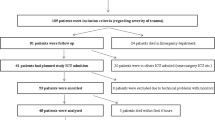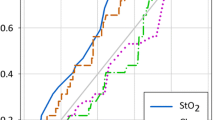Abstract
Background
Microdialysis allows the biochemical analysis of interstitial fluids. We investigated the dynamic changes of myocardial metabolism from patients with ischemic heart disease and with low left ventricular ejection fraction (EF <50%).
Methods
In 30 patients undergoing coronary artery bypass grafting, a microdialysis catheter was inserted in the left heart in an area of abnormal ventricular contraction. A second catheter was placed in the normal tissue of the right ventricle. Microdialysis measurements were performed in the perioperative course.
Results
During CBP both ventricles showed signs of poor tissue oxygenation. The glucose-lactate ratio (GLQ) as a marker of nutritional disorder of the right ventricle had significantly better values at this point. Glycerol was significantly higher in the left myocardium. The postoperatively increased lactate-pyruvate ratio of three patients was associated with acute myocardial infarction.
Conclusions
Conclusions GLQ and glycerol values as markers of anaerobic metabolism and cell membrane desintregity, respectively, showed signs of rising in both ventricles during cardioplegic arrest, but were significantly higher in the left ventricle due to underlying ischemic coronary disease. Myocardial microdialysis is an useful tool in rapid intraoperative detection of ischemia.
Zusammenfassung
Einige Patienten weisen ein erhöhtes Risiko auf, in der frühpostoperativen Phase nach aortokoronarer Bypassoperation ein Pumpversagen zu erleiden. Es besteht das klinische Interesse, das allgemeine systemische Stoffwechselmonitoring auf den direkten zellulären Stoffwechsel des Herzens zu erweitern. Mit dem Verfahren der Mikrodialyse besteht die Möglichkeit, in allen Geweben Stoffwechselveränderungen semikontinuierlich auf zellulärer Ebene zu erfassen.
Mikrodialysekatheter wurden in ein dyskinetische Segment des linken Ventrikels und in ein normokontraktäres Areal der rechten Kammer platziert. Es wurden myokardiale Glucose-, Pyruvat-, Glycerol- und Latatkonzentrationen bestimmt und hieraus anschließend der Laktat-Glucose-Quotient (GLQ) sowie der Laktat-Pyruvat-Quotient (LP) ermittelt.
Die Glycerolkonzentration erreichten währen der Aorten klemmzeit signifikant in den dyskinetischen Segmenten deutlich höhere Werte (Glycerol: 146±67 μmol/l vs. 72±36 μmol/l). Der GLQ erzielte im Bereich der normokontraktilen Gebiete der Klemmzeit deutlich bessere Werte (1,46±0,75 μmol/l vs. 0,61±0,25). Frühpostoperativ zeigten beide Ventrikel eine schnelle Erholung aller Parameter. Bei drei Patienten kam es frühpostoperativ aufgrund einer Bypassdysfunktion zu einem Wiederanstieg des LP-Quotienten (15±7 vs. 108±67) sowie zu einem erneutem Abfall des GLQ.
Diese Art der Stoffwechselüberwachung kann sehr gut geeignet sein, die bisherigen Methoden des Monitorings zu ergänzen und hinsichtlich der Diagnostik und Therapiesteuerung kritisch kranker Patienten wertvolle zusätzliche Informationen zu liefern. Es lassen sich frühzeitig Veränderungen aufdecken, obwohl das hämodynamische Monitoring oder der systemische Stoffwechsel noch unauffällig sein kann.
Similar content being viewed by others
Literatur
Breisblatt WM, Stein KL, Wolfe CJ, Follansbee WP, Capozzi J, Armitrage JM, Hardesty RL (1990) Acute myocardial dysfunction and recovery: a common occurrence after coronary bypass surgery. J Am Coll Cardiol 15:1261–1269
O'Connor GT, Plume SK, Olmstead EM, Coffin LH, Morton JR, Maloney CT, Nowicki ER, Levy DG, Tryzelaar JF, Hernandez F (1992) Multivariate prediction of in-hospital mortality associated with coronary artery bypass graft surgery. Northern New England Cardiovascular Disease Study Group. Circulation 85:2110–2118
Christakis GT, Weisel RD, Fremes SE, Ivanov J, David TE, Goldman BS, Salerno TA (1992) Coronary artery bypass grafting in patients with poor ventricular function. J Thorac Cardiovasc Surg 103:1083–1092
Prause G, Ratzenhofer-Comenda B, Smolle-Juttner F, Heydar-Fadai J, Wildner G, Spernbauer P, Smolle J, Hetz H (2001) Comparison of lactate or BE during out-of-hospital cardiac arrest to determine metabolic acidosis. Resuscitation 51:297–300
Vagts D, Nöldge-Schomburg G (2001) Hämodynamisches Monitoring des Splanchikusgebietes. Überwiegt der Nutzen das Risiko des teilkreislaufbezogenen Monitorings? Anaesthesiol Reanimat 26:96–101
Raman JS, Bellomo R, Hayhoe M, Tsamitros M, Buxton BF (2001) Metabolic changes and myocardial injury during cardioplegia: a pilot study. Ann Thorac Surg 72:1566–1571
Korth U, Klein J (2001) Methodik und Anwendung der Mikrodialyse. Anästhesiologie und Intensivmedizin 34:732–739
Ungerstedt U (1991) Microdialysis: principles for studies in animals and man. J Intern Med 230:365–373
Opie LH, Mansford KR, Owen P (1971) The value of lactate and pyruvate measurements in the assessment of the redox state of free nicotinamide-adenine dinucleotide in the cytoplasm of perfused rat heart. Eur J Clin Invest 1:295–306
Buckberg GD (2001) Cardioplegia solutions– unproven herbal approach versus tested scientific study. Semin Thorac Cardiovasc Surg 13:52–55
Kennergren C, Mantovani V, Lönnroth P, Nystrom B, Berglin E, Hamberger E (1999) Monitoring of extracellular aspartate aminotransferase and troponin T by microdialysis during and after cardioplegic heart arrest. Cardiology 92:162–170
Heringlake M, Bahlmann L, Misfeld M, Poeling J, Leptien A, Kraatz E, Klaus S (2005) High myocardial lactate concentration is associated with poor myocardial function prior to cardiopulmonary bypass. Minerva Anestesiol 71:775–783
Poeling J, Rees W, Klaus S, Bahlmann L, Gumniah M, Ziaukas V, Warnecke H (2006) Cardiac biochemical monitoring for the detection of acute myocardial ischemia. Intensive Care Med 32:628–629
Bahlmann L, Misfeld M, Klaus S, Leptien A, Heringlake M, Schmucker P Sievers HH, Ungerstedt U, Kraatz EG (2004) Myocardial redox state during coronary artery bypass grafting assessed with microdialysis. Intensive Care Med 30:889–894
Hutchinson PJ, O'Connell MT, al- Rawi PG, Kett-White R, Gupta AK, Kirkpatrick PJ, Pickard JD (2002) Clinical cerebral microdialysis–determining the true extracellular concentration. Acta Neurochir (Suppl):81:359–362
Luchette FA, Jenkins WA, Friend LA, Su C, Fischer JE, James JH (2002) Hypoxia is not the sole cause of lactate production during shock. J Trauma 52:415–419
James JH, Luchette FA, McCarter FD, Fischer JE (1999) Lactate is an unreliable indicator of tissue hypoxia in injury or sepsis. Lancet 354:505–508
Schoder H, Knight RJ, Kofoed KF, Schelbert HR, Buxton DB (1998) Regulation of pyruvate dehydrogenase activity and glucose metabolism in post-ischaemic myocardium. Biochim Biophys Acta 27:62–72
Panchal AR, Comte B, Huang H, Dudar B, Roth B, Chandler M, Des Rosiers C, Brunengraber H, Stanley WC (2001) Acute hibernation decreases myocardial pyruvate carboxylation and citrate release. Am J Physiol Heart Circ Physiol 281:1613–1620
Nilsson OG, Brandt L, Ungerstedt U, Säveland H (1999) Bedside detection of brain ischemia using intracerebral microdialysis: subarachnoid hemorrhage and delayed ischemic deterioration. Neurosurgery 45:1176–1185
Author information
Authors and Affiliations
Corresponding author
Rights and permissions
About this article
Cite this article
Pöling, J., Rees, W., Klaus, S. et al. Perioperatives myokardiales Monitoring von bypassoperierten Patienten. Intensivmed 44, 98–103 (2007). https://doi.org/10.1007/s00390-006-0742-x
Received:
Accepted:
Issue Date:
DOI: https://doi.org/10.1007/s00390-006-0742-x




